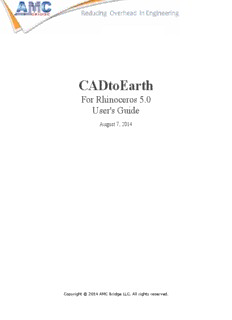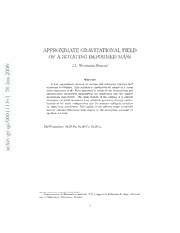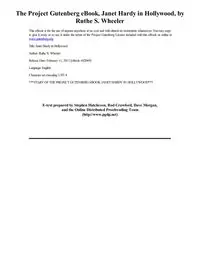
A NOVEL TRAP TO CAPTURE BALLOONING SPIDERS PDF
Preview A NOVEL TRAP TO CAPTURE BALLOONING SPIDERS
2007. The Journal of Arachnology 35:307-312 A NOVEL TRAP TO CAPTURE BALLOONING SPIDERS Chris Woolley C. F. George Thomas and Linda Hutchings: School of Biological , Sciences, University of Plymouth, Drake Circus, Plymouth, Devon, PL4 8AA, UK. E-mail: c.woolley@plymouth.ac.uk Sara Goodacre and Godfrey M. Hewitt: School of Biological Sciences, University of East Anglia, Norwich, NR4 7TJ, UK Steve P, Brooks: Statistical Laboratory, Centre for Mathematical Sciences, Wilberforce Road, Cambridge, CB3 OWB, UK ABSTRACT. An unattendedtrap was designedto sample andretain spiders dispersingfromagricultural grassland and crops. Traps comprised a removable bottle-trap fixed to the top of a vertical metal rod or “climbing-stick” that spiders climbed during normal pre-ballooning behavior. Bottle-traps caught over eight times more spiders than sticks treated with insect trapping adhesive. Draping sticks with nets in- - creased the effective area ofthe traps and increased the catch size threefold. On average, 9.1% ofspiders were lost from traps during the daytime sampling period. No difference in average rate ofloss ofspiders from thebottle-traps was observedbetween night and daylighthours. The bottle-trap design is economical and simple to construct, erect and operate. Continuous sampling also allows multiple traps to be used simultaneously in various locations. Keywords; Aerial dispersal, sampling, bottle-trap, climbing-stick Aerial dispersalby ballooning is akey strat- the climbing behavior normally exhibited by egy in the life histories of many spiders, es- spiders as a precursor to ballooning (Black- pecially pioneers of disturbed, patchy habitats wall 1827): spiders climb to a high point exemplified by lieyphiids in agricultural land- where a silk line can be produced above the scapes (Thomas et aL 2003a). Quantifying the surrounding vegetation and where suitable at- dispersal power ofthese species is a necessary mospheric conditions for successful balloon- prerequisite for accurately modeling spatial ing are likely to occur (Suter 1999). Sticks, population dynamics and developing success- canes or similar objects inserted into the ful sustainable management strategies. Vari- ground, provide artificial platforms that stand ous techniques that actively or passively in- higher than the surrounding vegetation. Spi- tercept airborne spiders have been used to ders climbing and attempting to balloon from measure aspects of aerial dispersal. For ex- these can be observed, or caught and counted, ample: the use ofnets and sticky traps to mea- to give a relative Indication of ballooning ac- sure aerial density at one or more altitudes tivity over a given period. Tborbek et al. (Greenstone et aL 1987; Greenstone 1991; (2002), in avalidation ofthis technique, found Thomas et aL 2003b); manual collection from that numbers of spiders observed climbing a fences, wire, or string to quantify numbers 30 cm stick correlated well with numbers ob- & passing a point or line per unit time (Vugts tained from an aerial suction trap. Using a Van Wingerden 1976; Thomas et al. 2003b); similar technique to sample several habitats or water traps to quantify deposition rates per over time, Duffey (1956) applied a tacky ad- unit area (Weyman et al. 1995; Thomas & hesive to the tops of canes to trap climbing Jepson 1999). These methods are either labor spiders. However, the adhesive was adversely intensive, require operator attendance, cannot affected by hot, cold or wet weather and be- easily sample several locations at the same came clogged with winged insects during time, or may be cumbersome or expensive. summer months. An alternative sampling method exploits This paper describes and evaluates a novel 307 308 THE JOURNAL OF ARACHNOLOGY — Figures 1-6. Trap construction. 1. Two liter soft-drinks bottle. 2. Bottle bottom with the five rein- forcements removed. 3. Top removed and section below discarded. 4. Inverted top inserted into the re- maining section and secured with adhesivetape. 5. Screw cap gluedunderneaththecentralhub. 6. Finished trap with fine gauze fastened in place with a rubber band. design that develops the climbing-stick into a heated scalpel blade, the material between the trap to allow continuous unattended sampling five reinforcing moldings in the base (Fig. 2). without the use of adhesive. Attached to the The top section of the bottle was then re- top of a climbing-stick is a “bottle-trap” op- moved, just below the shoulder, approximate- erating on the lobster-pot principle. Climbing ly 9 cm from the top of the bottle opening spiders are retained within the bottle-trap until (Fig. 3). A band approximately 7 cm deep was it is removed or replaced. In the present paper cut away from the main body and discarded. we compare the trapping efficiencies ofclimb- The removed top section was then inverted ing sticks either with bottle-traps or with ad- and fixed into the remaining base section of hesive. the bottle using adhesive tape (Fig. 4), ensur- The trap collects spiders climbing from the ing no gaps remained between the two sec- underlying vegetation before they firstbecome tions. A 2 ml micro-tube screw-cap (Sar- & airborne, and spiders already airborne arriving stedt®, A.G. Sarstedt Co, Niimbrecht, at the trap from sources upwind. In the present Germany) was glued with super-glue (Loc- paper we do not differentiate between these tite®, Henkel, Dusseldorf, Germany) centrally two potential sources. However, we evaluate beneath the now inverted base section and the effect of suspending a net skirt from the above the original bottle top opening forming climbing-stick to increase the effective verti- the new base (Fig. 5). A 20 X 20 cm square cal and horizontal cross-sectional area of the of white voile gauze fabric was then fastened trap. This increases both the source area of tightly over the five cut-away openings with spiders emerging from the ground and the in- a rubberband (Fig. 6). The cut-away openings terception of airborne spiders. covered in fine gauze voile material allowed METHODS vertical air flow, general ventilation and, when — removed, the extraction of spiders from the Trap construction. The “lobster-pot” trap. part comprising the bottle-trap was construct- The climbing-stick was made from a 1.5 m mm ed from a standard straight-sided, clearplastic, length of7.9 diameter aluminum rod. The 2-liter soft-drinks bottle (Fig. 1). The body of surface was roughened with sandpaper to as- the trap was made by first removing, with a sist climbing spiders. — WOOLLEY ET AL. NOVEL DESIGN OF CLIMBING-STICK TRAP 309 — Figures 7-11. Trap construction. 7. Micro-tube. 8. Micro-tube with bottom removed, pushed over the end ofthe climbing-stick and glued in position. 9. Circular wire frame. 10. Netting pulled over pole with circular wire frame placed over netting. 11. Finished trap with bottle-trap screwed on and net clipped to stick. An attachment for the bottle-trap was made form a cone and the climbing-stick placed using the body of the 2 ml micro-tube from through the apex before the stick was pushed which came the cap that had been glued to the into the ground. The net was then clipped to bottle-trap. The bottom section of the main the stick using a small bulldog clip set at an body was removed just above the taper (Fig. angle to ensure the spiders continued climb- 7). A small amount ofrapid drying epoxy res- ing. The circular wire base was held down in (Araldite®, Huntsman Advanced Materials, with wire pegs or stones. The bottle-trap was Everberg, Belgium) was applied to the inside thee screwed to the top of the stick (Fig. 11). of the tube, which was then placed over the For continual sampling, bottle-traps were end of the climbing-stick with the thread end unscrewed and replaced with empty ones. For uppermost and extending approximately 5 daily samples reported here, traps were typi- mm above the end (Fig. 8). cally changed each evening after ballooning The net was constructed from 2 cm mesh behavior had finished. Removed traps were bird netting made from a natural-fibre twine. placed in plastic bags in the field before re- Sufficient material to form a small tent was turning to the lab. Spiders were extractedfrom draped over a 1.2 m wooden pole. A 3.14 m traps by removing the voile gauze and shaking mm length of 2 fencing wire, formed into a 1 vigorously over a tray from which spiders m diameter circle (Fig. 9) was placed over the were collected with an aspirator. Any spiders netting and pole to weigh down the base of remaining in the trap were removed either the net and keep it splayed out. The netting with an aspirator or, if there was a lot of silk was pulled taut over the pole, arranged evenly in the trap, with a sm—all paint brash. around the frame, and its hem secured to the Trap evaluation. Experiments were per- circular base with wire ties before cutting formed with traps set along a transect in an 8 away excess material. (Fig. 10). — ha grass field on the estate farm at the Seale- Setting and operating the trap* To set Hayne Faculty, Newton Abbot, Devon, in the the trap, the climbing-stick was pushed verti- southwest ofthe UK. The temporary grass ley mm cally into the ground, and a bottle-trap placed was approximately 150 tall at the time of over and screwed to the top of the stick. If a sampling. The transect, orientatednorth-south, net was also used, this was first pulled up to traversed the brow of a hill, the mid-section 310 THE JOURNAL OF ARACHNOLOGY — Table 1. Total number of spiders caught per trap over an 1 1 day period from climbing-sticks with bottle-traps and climbing-sticks with adhesive. Trap number 1 2 3 4 5 6 7 8 9 10 Bottle-trap 18 17 14 46 78 107 131 75 53 25 Adhesive 1 6 8 9 6 5 16 7 8 0 being elevated relative to the extremities. An minimize further ingress of spiders. Numbers electric fence was used to protect the transect of spiders remaining in the traps were again from disturbance by sheep and cattle that pe- recorded at 09:00 and at 17:00 the following riodically grazed the field. day. Three aspects of the trap were evaluated: RESULTS catch size from climbing-sticks with bottle- traps compared with climbing-sticks with a Comparison between climbing-sticks polybutene-based insect trapping adhesive with bott—le-traps and climbing-sticks with (Oecotak A5®, Oecos Ltd, Kimpton, Hert- adhesive. For all traps, catch sizes were fordshire, England) applied to the uppermost higher for climbing-sticks with bottle-traps 15 cm of the stick; catch size from climbing- than for climbing-sticks with adhesive (Table sticks and bottle-traps with and without nets; 1). Total catch size over the period for climb- retention of spiders left in bottle-traps during ing-sticks with bottle-traps was 564 spiders the day and overnight. and for climbing-sticks with adhesive, 66 spi- To compare catch size from climbing-sticks ders. with either bottle-traps or adhesive, 10 traps Comparison b—etween bottle-traps with m of each design were set alternately at 10 and without nets. Climbing-sticks with nets intervals. Bottle-traps were emptied on each caught greater numbers of spiders than those of 11 successive days in March 2003; climb- without nets for 7 days out of the 13 day pe- ing-sticks with adhesive accumulated spiders riod (Table 2). Spiders were not recorded in over the same period. Climbing sticks with any trap on 22, 23, 24, 28, and 29 March adhesive were checked periodically to ensure when high wind speeds suppressedballooning that the accumulation oftrapped spiders or in- activity. No differences were recorded on 26 sects was not excessive and that there was am- March though catch size was very low with ple exposed adhesive to maintain capture ef- only 2 spiders recorded in all traps together. ficiency. Total numbers caught per trap were The total numbers of spiders caughtby climb- recorded at the end of the sampling period. ing-sticks with and without nets were 641 and For catch size evaluations comparing climb- 218 respectively. — ing-sticks and bottle-traps with and without Retention of spiders in bottle-traps. Of nets, 10 traps of each design were set alter- a total of 413 spiders in 10 bottle-traps re- nately at 10 m intervals. Samples were taken corded at 17:00, 69 (15.3% ± 11.8%) had es- A and recorded daily over a 13 day period in caped by 09:00 the following morning. fur- March 2004. For the retention study, 10 ther 35 (9.1% ± 7.7%) escaped between 09: climbing-sticks with bottle-traps were placed 00 and 17:00. The average loss over 24 h was in the field as above. Numbers of spiders in 24.4% ± 16.6%. A significant linear regres- each bottle-trap were recorded after 24 h at sion (adjusted R2 = 63.6%, P = 0.004) be- 17:00. Traps were then relocated to a tarmac tween initial numbers caught and numbers lost substrate away from ground vegetation to after 24 h indicated losses to be largely den- — Table 2. Daily totals of spiders caught for all traps with and without nets. Date 18/3 19/3 20/3 21/3 22/3 23/3 24/3 25/3 26/3 27/3 28/3 29/3 30/3 Nets 14 324 41 46 0 0 0 147 4 1 0 0 64 No nets 2 137 8 7 0 0 0 57 1 1 0 0 5 — WOOLLEY ET AL. NOVEL DESIGN OF CLIMBING STICK TRAP 311 sity independent. Mean rate of loss (± SE) months in order to prevent cross contamina- from traps between 17:00 and 09:00 was tion with the previous day's sample. If longer 0.431 ± 0.141 spiders per hour and from 09: duration sampling is required and live spiders 00 to 17:00, 0.438 ± 0.148 spiders per hour. are not, a preserving fluid could be introduced No significant difference in rate of loss was into the bottom section ofthe bottle-trap. Spi- observed between night and day hours (F(U8) ders would fall into this, thereby reducing = 0.01, P = 0.976). losses and minimizing any build-up of silk. A large variation in catch size was observed DISCUSSION along the transect, particularly for the bottle- Climbing-sticks with bottle-traps are ex- traps. This was possibly due to the greater tremely effective, cheap and easy to make and trapping efficiency of the bottle-traps coupled use. We estimate the cost of construction ma- with the undulating nature of the field, the terials to be less than $9 US pertrap atcurrent greatest catch size being recorded at the high- prices. Apart from the greater catch size, est elevation. which, in total, was over eight times that of Linyphiids were by far the commonest spi- climbing sticks with adhesive, the bottle-traps ders caught by the traps, being highest both also retain the advantage of easy replication in numbers and in occurrence throughout the and the ability to simultaneously sample dif- year. Other spiders caught in lesser numbers ferent habitats at large spatial and/or short belonged to the families Thomisidae and Ar- temporal scales. The retention of live spiders aneidae. Though immature thomisids were ob- means trapping agents such as adhesive orwa- served ballooning, adults of these families ter and detergent are not required. Further- may have been present in traps as an accident more, additional behavioral, ecological or ge- of other behaviours such as rigging, locating netic studies can be carried out on the trapped shelter/feeding sites or web building. Care spiders if required. must therefore be taken before attributing dis- The addition ofnets to climbing sticks with persal by ballooning to all spiders caught. bottle traps increased catch size almost three The bottle-traps sometimes caught other in- fold. The trials reported here were conducted sects including bush crickets, cantharid bee- in short grass. However, in other trials con- tles, ephemeropterans, plecopterans, tipulids ducted in taller crops, such as wheat, it was and various other dipterans. Some of this by- necessary to use 2.5 m climbing-sticks to raise catch might prey on spiders but we did not the nets and bottle-traps above the crop in or- see any evidence for this. Otherpotential loss- der to intercept airborne spiders. For compar- es are likely from predation among spiders but ative work sampling airborne spiders above this was not quantified and is likely only if crops of differing height, traps should be set traps are left operating unchanged for longer at a constant height above the roughness periods. length of the vegetation. ACKNOWLEDGMENTS Although losses from traps left operating for several consecutive days can be estimated, This work was funded through BBSKC it is recommended that the traps are emptied grants D14032, D20476 and D14036. We daily, unless spiders are being collected only would like to thank all the technical and farm for laboratory studies. This avoids large staffat Seale-Hayne fortheir assistance in this amounts of silk accumulating inside the bot- work. tle-traps which makes separation of the spi- LITERATURE CITED ders from the silk difficult and extraction much more time-consuming. Similarly, when Blackwall, J. 1827. Observations and experiments, large numbers of spiders were caught within made with a view to ascertain the means by a single day, we found traps were best emp- which the spiders that produce gossamer effect tied immediately after collection because of their aerial excursions. Transactions of the Lin- nean Society of London 15:449-459. Wthee qfuoanutnidtytorafpssilwkeprreodbuecsetd rifelmeoftveovderinnightth.e Dufpfoepyu,laEt.io1n9.56J.ouArenrailalodfisApnerismaallinEacoklnoogwyn2s5p:i8d5e-r evening after ballooning had finished. If traps 111 . cannotbe changed until the morning, it should Greenstone, M.H. 1991. Aerial dispersal of arthro- be carried out very early during summer pod natural enemies: altitudinal differences in 312 THE JOURNAL OF ARACHNOLOGY taxonomic distributions of dispersers. Pp. 104— Thomas, C.F.G., P. Brain & P.C. Jepson. 2003b. Ae- 106. In Proceedings of the 10th Conference on rial activity of linyphiid spiders: modeling dis- Biometeorology and Aerobiology and the Spe- persal distances from meteorology and behav- cial Session on Hydrometeorology. American iour. Journal of Applied Ecology 40:912-927. Meteorological Society, Boston, Massachusetts. Thomas, C.F.G. & P.C. Jepson. 1999. Differential Greenstone, M.H., C.E. Morgan, A.-L. Hultsch, aerial dispersal oflinyphiid spiders from a grass R.A. Farrow & J.E. Dowse. 1987. Ballooning and a cereal field. Journal of Arachnology 27: spiders inMissouri, USA, andNew SouthWales, 294-300. Australia: family and mass distributions. Journal Thorbek, R, CJ. Topping & K.D. Sunderland. of Arachnology 15:163-170. 2002. Validation of a simple method for moni- Suter, R.B. 1999. An aerial lottery: the physics of toring aerial activity of spiders. Journal of Ar- ballooning in a chaotic atmosphere. Journal of achnology 30:57-64. Arachnology 27:281-293. Vugts, H.F. & W.K.R.E. VanWingerden. 1976. Me- Thomas, C.F.G., R.P. Blackshaw, L. Hutchings, C. teorological aspects of aeronautic behaviour of WS.ooBllreoyo,ksS.&GooR.dacHraerr,inGg.tMo.n.He2w0i0t3ta,.K.MoIdberlalhiinmg, Weyspmiadenr,s.GO.iSk.,osP2.C7.:4J3e3p-s4o4n4.& K.D. Sunderland. life-history/dispersal-strategy interactions to pre- 1995, Do seasonal-changes in numbers of aeri- dict and manage linyphiid spider diversity in ag- ally dispersing spiders reflect population density ricultural landscapes. Pp. 167-172. In Interna- on the ground or variation in ballooning moti- tional Organization for Biological Control WPRS Bulletin, Volume 26. LandscapeManage- vation? Oecologia 101:487-493. ment for Functional Biodiversity. (W.A.H. Ross- ing, H-M. PoeMing & G. Burgio, eds.). Univer- Manuscript received 5 June 2006, revised 27 Jan- sity of Bologna, Italy. uary 2007.
The list of books you might like

The Sweetest Oblivion (Made Book 1)

Mind Management, Not Time Management

The 48 Laws of Power

The Mountain Is You

The God of that Summer

DTIC ADA593709: Regulation of TRAIL-Medicated Apoptosis in Prostate Cancer by Overexpression of XIAP

DTIC ADA450305: Central Asia and Its Asian Neighbors: Security and Commerce at the Crossroads

Insecticidal characteristics of the desert stingbush (Eucnide urens)

Évaluations formative et certificative des apprentissages

Hindi Kahanikaro Ke Kathachintan Ke Sandrabh Main Unke Kahani Sahitya Ka Mulyakan

Stefania coxi

Precious Memories by George C. Lambert

CADtoEarth Web Application - Log In - AMC Bridge

The Restaurant: From Concept to Operation

O Drama da Bretanha

caderno de resumos caderno de resumos

Sus

Anaphylaxis

cai altare 2018 libretto

Approximate gravitational field of a rotating deformed mass

Janet Hardy in Hollywood by Ruthe S Wheeler



